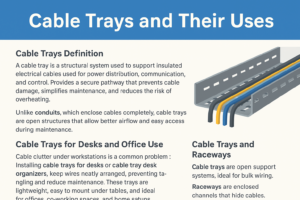
When it comes to modern wiring systems, cable trays play an essential role in managing, protecting, and organizing cables. Whether you are setting up electrical wiring in an office, industrial plant, or even under a desk, choosing the right cable tray ensures safety, efficiency, and neatness. In this blog, we will explore the definition of cable trays, their types, and how they differ from other systems such as conduits, raceways, and trunking.
Cable Trays Definition
A cable tray is a structural system used to support insulated electrical cables used for power distribution, communication, and control. It provides a secure pathway that prevents cable damage, simplifies maintenance, and reduces the risk of overheating.
Unlike conduits, which enclose cables completely, cable trays are open structures that allow better airflow and easy access during maintenance.
Cable Trays for Desks and Office Use
Cable clutter under workstations is a common problem. Installing cable trays for desks or cable trays desk organizers keeps wires neatly arranged, preventing tangling and reducing tripping hazards. These trays are lightweight, easy to mount under tables, and ideal for offices, co-working spaces, and home setups.
If you are searching online, you will often find queries like “cable trays near me.” This shows the rising demand for compact tray solutions for office and desk wiring.
Cable Trays and Raceways
Though often confused, cable trays and raceways serve different purposes.
-
Cable trays: Open support systems, ideal for bulk wiring.
-
Raceways: Enclosed channels that hide cables, giving a cleaner finish.
For areas requiring both accessibility and aesthetics, trays and raceways are often combined for effective cable management.
Cable Trays and Accessories
To ensure proper installation, cable tray accessories are crucial. These include:
-
Tray covers for dust protection
-
Bends and elbows for direction changes
-
Joints and clamps for support
-
Splice plates for joining sections
Using the right cable trays and accessories improves durability and safety of the electrical system.
Cable Trays and Conduits
Both cable trays and conduits are designed for cable support, but they differ in application:
-
Conduits: Fully enclosed pipes, ideal for high-protection areas.
-
Cable trays: Open systems, best for easy cable laying and maintenance.
Industries often use both together depending on the environment.
Cable Trays and Trunking
Another comparison often made is between cable trays and trunking.
-
Cable trunking hides cables completely within a rectangular enclosure.
-
Cable trays provide a more open system, suitable for large cable bundles.
Trunking is popular for commercial spaces requiring aesthetics, while trays are chosen for industrial areas needing easy inspection.
Importance of Earthing While Installing Cable Trays
While installing any cable tray system, proper earthing is important to ensure electrical safety. Since cable trays are made of conductive materials like GI, MS, or aluminum, they can become a path for electrical faults if not grounded correctly.
-
Earthing prevents accidental shocks.
-
It protects cables and connected equipment from fault currents.
-
It ensures compliance with safety standards (IS/IEC regulations).
Therefore, every cable tray installation must include correct earthing connections along with accessories, raceways, or conduits for a safe and reliable electrical system.
Conclusion
From cable trays for desks in office setups to industrial installations with conduits, raceways, and trunking, choosing the right cable management system ensures safety, neatness, and long-term performance. With the right cable trays and accessories, you can design a wiring system that is efficient, reliable, and easy to maintain.
